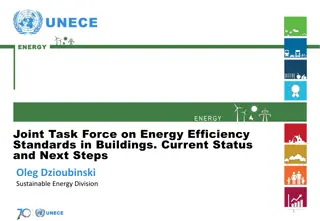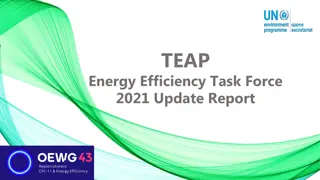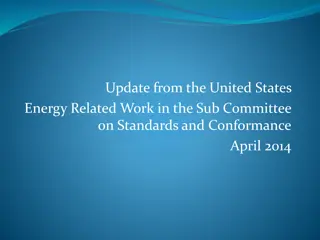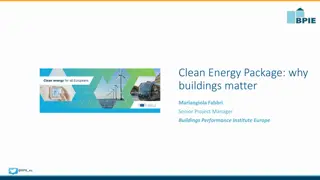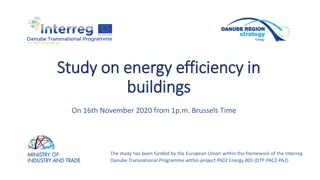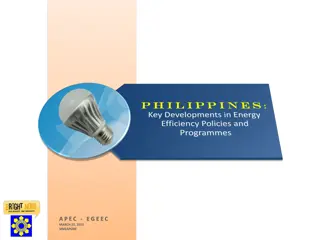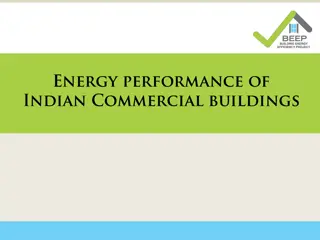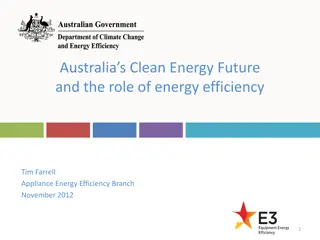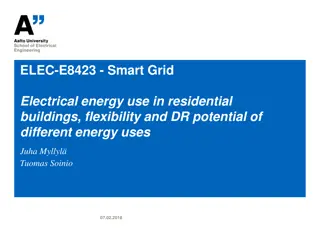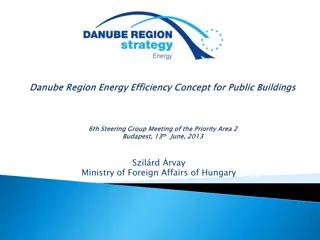Understanding EU Legislation and Energy Efficiency in Buildings
This module explores the EU legislation and energy efficiency in buildings with a focus on Nearly Zero Energy Building (nZEB) concepts. It covers the importance of increasing energy efficiency in buildings in the EU, showcasing statistics on energy consumption and CO2 emissions. By improving energy efficiency, significant reductions in energy consumption and emissions can be achieved, particularly in public buildings like educational facilities. The module aims to provide attendees with a solid understanding of the legal basis for energy efficiency in buildings within the EU.
Download Presentation

Please find below an Image/Link to download the presentation.
The content on the website is provided AS IS for your information and personal use only. It may not be sold, licensed, or shared on other websites without obtaining consent from the author. Download presentation by click this link. If you encounter any issues during the download, it is possible that the publisher has removed the file from their server.
E N D
Presentation Transcript
Block 2: Energy efficiency in buildings 2.1. nZEB legislation in EU E-learning course FEEDSCHOOLS, by RIC PRO-AKADEMIA
This module is part of a training package developed to provide local authorities with free tuition that may inspire and help them in adopting new technical and financial solutions to implement nearly Zero Energy Building (NZEB) renovation activities in schools. This block is meant to introduce you to EU legislation related to energy efficiency of buildings and NZEB. Beside regulations introduced at the European level, examples of their implementation in selected countries will be presented. Beginner: No special knowledge is needed. Intermediate: No special knowledge is needed. Advanced: No special knowledge is needed. TAKING COOPERATION FORWARD
2.1.3 nZEB concept and its implementationin selectedEU countires 2.1.1 Motivation energy consumption in buidlings in the EU 2.1.2 Key provisions for Member States regarding energy efficiency Learning Objective: At the end of this module attendees will be provided with general knowledge about legal basis of energy efficiency in buildigns in the EU. TAKING COOPERATION FORWARD
2.1.1 Motivation energy consumption in buidlings in the EU Objective In this unit you will learn why increasing energy energy efficiency in buildings is important in the EU. TAKING COOPERATION FORWARD
According to European Commission data, buildings are responsible for 40% of energy consumption and 36% of CO2emissions in the EU. Currently, about 35% of EU buildings are over 50 years old. 75% of the existing European building stock is energy inefficient, and estimates show that 90% of these buildings will still be in use by 2050. Source: https://ec.europa.eu/info/sites/info/files/epbd_factsheet_20180503_dc_v03e_final.pdf TAKING COOPERATION FORWARD
By improving the energy efficiency of buildings, total EU energy consumption could be reduced by 5-6%, whilst CO2emissions could decrease by about 5%. Among the public buildings, the educational buildings account 17% of the built area and 12% of the final energy use of the non-residential sector in Europe. Source: https://ec.europa.eu/energy/en/topics/energy-efficiency/buildings TAKING COOPERATION FORWARD
2.1.2 Key provisions for Member States regarding energy efficiency Objective In this unit you will learn which EU directives are essential in terms of energy efficiency of buildings, and what requirements they put on EU Member States TAKING COOPERATION FORWARD
Directive 2010/31/EU on the energy performance of buildings (EPBD) Sets minimum energy performance requirements for new buildings, for the major renovation of buildings and for the replacement or retrofit of building elements Requires that all new buildings must be nearly zero-energy buildings ( nZEB ) since 2021. Requires that buildings occupied and owned by public authorities must be nZEB since 2019. Member States are required to develop National Plans for increasing the number of NZEBs TAKING COOPERATION FORWARD
Directive 2012/27/EU on energy efficiency (EED) Member States are required to make energy efficient renovations to at least 3% of buildings owned or leased by the central government every year, Member States are required to develop long-term building renovation strategies. TAKING COOPERATION FORWARD
Directive (EU) 2018/844 amending 2010/31/EU and 2012/27/EU directives Each Member State shall establish a long-term renovation strategy (residential & non-residential buildings, public & private) facilitating the cost-effective transformation of existing buildings into nearly zero-energy buildings by 2050. milestones for 2030, 2040 and 2050 the long-term 2050 goal of reducing greenhouse gas emissions in the EU by 80-95 % compared to 1990 Member States shall not only to set a national nZEB definition, but also to actively promote higher market uptake of such buildings. TAKING COOPERATION FORWARD
Each EU directive needs to be legally transposed by national laws. The following deadlines have been set for the transposition: Directive 2010/31/EU on the energy performance of buildings (EPBD) Directive 2012/27/EU on energy efficiency (EED) Directive (EU) 2018/844 2012-07-09 Selected articles: 2013-01-09 2013-07-09 2015-12-31 2014-07-05 2020-03-10 TAKING COOPERATION FORWARD
2.1.3 nZEB concept and its implementation in selected EU Countires Objective In this unit you will learn what does nearly-zero energy building mean and how selected Central European countries implemented this concept into their national regulations TAKING COOPERATION FORWARD
General definition: Nearly-zero-energy building means a building that has a very high energy performance. The nearly zero or very low amount of energy required should be covered to a very significant extent by energy from renewable sources, including energy from renewable sources produced on-site or nearby. EPBD Directive (2010/21/EU) National definitions are required. Beside the general implications from the directive, they also need to: reflect national, regional or local conditions; include a numerical indicator of primary energy use expressed in kWh/m2 per year. TAKING COOPERATION FORWARD
Each Country develops its own definition Definitions should cover various building types, classes and categories Type Classification Category Subcategory New Renovated Private Public Residential Non- residential apartment blocks offices educational buildings hospitals hotels wholesale and retail buildings Source: Synthesis Report on the National Plans for Nearly Zero Energy Buildings (NZEBs), JRC, 2016 TAKING COOPERATION FORWARD
Country Residential buildings (kWh/m2/y) Non-residential buildings (kWh/m2/y) Notes New Existing New Existing Austria 160 200 170 250 Maximum values; final value depends on the volume/surface rate Czechia 75-80% PE 75-80% PE 90% PE 90% PE PE - primary energy consumption of a reference building. Croatia 33-41 NA NA NA - Hungary 50-72 NA 60-115 NA - Italy Class A1 Class A1 Class A1 Class A1 - Poland 60-75 NA 45-70-190 NA Depending on building type Slovenia 75 (single family), 80 (multi- family) 95 (single family), 90 (multi- family) 55 65 - Source: Synthesis Report on the National Plans for Nearly Zero Energy Buildings (NZEBs), JRC, 2016 TAKING COOPERATION FORWARD
Croatia: Nearly zero energy building is a building that has very high energy performance. This almost zero or very low amount of energy should be covered to a considerable extent by energy from renewable sources, including renewable energy produced at or near the building. Technical regulation on energy economy and heat retention in buildings (Official Gazette 128/15) Slovenia: New construction Major renovation Family houses 50 kWh/m2a 90 Multi-dwelling 45 70 Non-residential 70 100 Czech Republic: Residential: 75-80% of a reference building Non-residential: 90% of a reference building PL 60 75 AT HR SI HU 50 170 33 41 75 80 50 72 200 kWh/m2a NZEB primary energy performance, new residential buildings Source: Synthesis Report on the National Plans for Nearly Zero Energy Buildings (NZEBs), JRC, 2016 TAKING COOPERATION FORWARD
Katarzyna Korczak Research and Innovation Centre Pro-Akademia www.proakademia.eu/en/ katarzyna.korczak@proakademia.eu facebook.com/ProAkademia/ twitter.com/CBI_ProAkademia/ linkedin.com/company/5154403/ TAKING COOPERATION FORWARD
SELF ASSESSMENT TEST Which of the following sentences are true? Majority of buildings in the EU is energy efficient Most of the energy-inefficient buildings in the EU will be demolished in the next three decades EU s CO2 emissions could be cut by 5% by improving the energy performance of buildings EU s CO2 emissions could be cut by 40% by improving the energy performance of buildings A. B. C. D. TAKING COOPERATION FORWARD
SELF ASSESSMENT TEST Which of the following sentences are true? Majority of buildings in the EU is energy efficient Most of the energy-inefficient buildings in the EU will be demolished in the next three decades EU s CO2 emissions could be cut by 5% by improving the energy performance of buildings EU s CO2 emissions could be cut by 40% by improving the energy performance of buildings A. B. C. D. TAKING COOPERATION FORWARD
SELF ASSESSMENT TEST Which of the following sentences are true? Since the beginning of 2021, all buildings (both existing and new) must be nZEB Currently public authorities cannot rent a building which is not nZEB There is no requirement to modernize existing buildings into nZEB only new buildings must meet that rule National governments are obliged to promote nZEB A. B. C. D. TAKING COOPERATION FORWARD
SELF ASSESSMENT TEST Which of the following sentences are true? Since the beginning of 2021, all buildings (both existing and new) must be nZEB Currently public authorities cannot rent a building which is not nZEB There is no requirement to modernize existing buildings into nZEB only new buildings must meet that rule National governments are obliged to promote nZEB A. B. C. D. TAKING COOPERATION FORWARD
SELF ASSESSMENT TEST Which of the following sentences are true? Nearly-zero energy building does not need any kind of energy Nearly-zero energy building should be equipped with renewable energy sources installation or supplied with energy coming from external renewables nZEB requirements for residential and non-residential buildings differ There is no common nZEB definition in the EU and each country can adjust it to its local conditions A. B. C. D. TAKING COOPERATION FORWARD
SELF ASSESSMENT TEST Which of the following sentences are true? Nearly-zero energy building does not need any kind of energy Nearly-zero energy building should be equipped with renewable energy sources installation or supplied with energy coming from external renewables nZEB requirements for residential and non-residential buildings differ There is no common nZEB definition in the EU and each country can adjust it to its local conditions A. B. C. D. TAKING COOPERATION FORWARD







